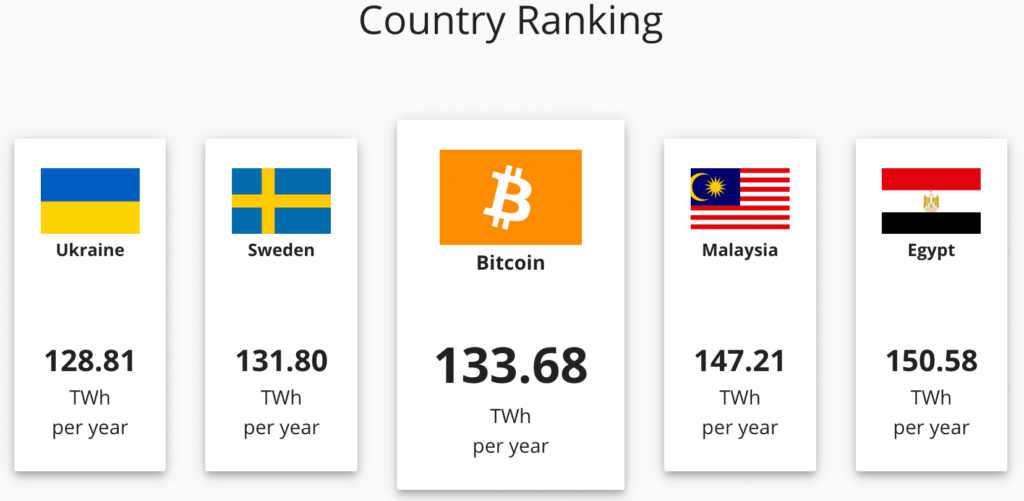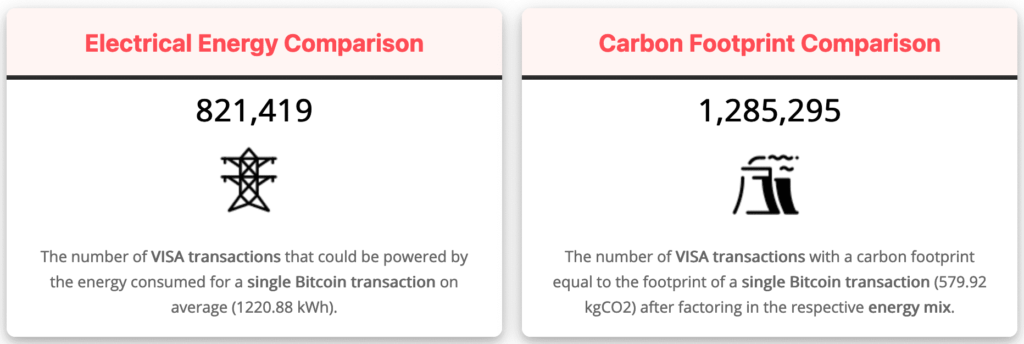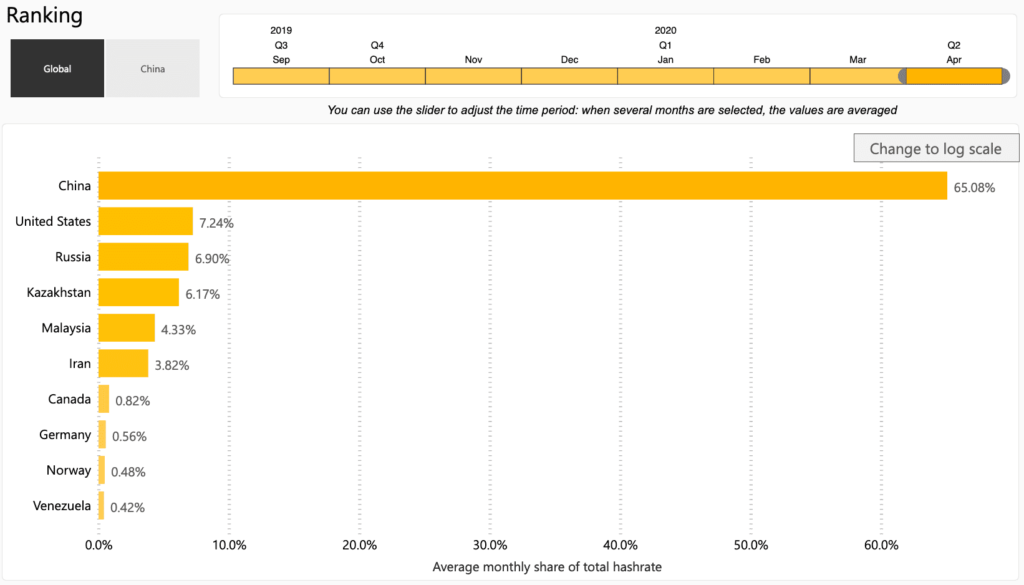Is bitcoin bad for the environment? Unlike most forms of currency issued by single entities (usually central banks), Bitcoin is based on a decentralized network. Its transactions are approved by different miners who simultaneously solve complex equations using specific hardware and plenty of energy. But how impactful is Bitcoin, really?
What Is Bitcoin? Is Bitcoin Bad For the Environment?
The promise of decentralization, free access, very little regulation and anonymity, plus the ability to make money out of transactions by “playing” with market rules work may be appealing for some.
Others, instead, can’t avoid looking away from Bitcoin’s algorithm and its demand for computational power to validate transactions.
But how polluting are Bitcoins exactly? How bad are Bitcoins for the environment?
Here’s a brief introduction to bitcoin from a sustainability perspective. Perfect to shed some light on how Bitcoin works for those reading about it for the first time.
What is Bitcoin and What Are Its Environmental Effects?
Simply put, Bitcoin is a digital currency created in 2009 following the ideas set out in a whitepaper by the pseudonymous Satoshi Nakamoto. It has its own website – which is perfectly safe to visit – where one can get started with Bitcoin by choosing a wallet to buy the cryptocurrency.
It delivers the promise of lower transaction fees than traditional online payment mechanisms – such as MoneyGram, Transferwise or Western Union – and, unlike government-issued currencies, it is operated by a decentralized authority thanks to the use of blockchain technology.
Though its value has been growing over the years, Bitcoin’s practical problems and inefficiencies have gradually come to light. From its lack of consumer protection to facilitating crimes like money laundering, tax evasion, buying drugs and weapons, or child pornography.
But these are not the issues we’re covering here.
Rather, we’re looking to understand why Bitcoin is bad for the environment. To do so, we must start by taking a look at Bitcoin’s underlying technology – blockchain – which makes this cryptocurrency truly energy-intensive.
Why Is Bitcoin Bad For the Environment? It Spends A Lot of Energy (and Elon Musk Knows It)
Bitcoin’s public ledger is decentralized, which means it is not controlled by any single authority. Instead, Bitcoin is constantly updated by a network of computers around the world operated by so-called “miners”.
These miners use purpose-built computers to solve complex math puzzles in order to allow transactions to go through – the only way to mint new bitcoins – in exchange for being rewarded a small fraction of the Bitcoins transactioned.
Over the last years, with the price of Bitcoin reaching new highs (and lows, as happened recently with Elon Musk’s Bitcoin Tweet), the attractiveness of mining Bitcoin lead the total energy consumption of the Bitcoin network to grow to epic proportions.
Since mining can provide a solid stream of revenue, the number of people – aka miners – willing to run power-hungry machines to make a small profit out of every Bitcoin transaction they help approve has skyrocketed.
As a result, the Bitcoin network now consumes more energy than many countries.
According to Digiconomist’s Bitcoin Energy Consumption Index, Bitcoin has such an impact on the environment (118.9TWh/year) – considering the huge amount of energy used – that it compares to the power consumption of countries like the Netherlands (117.1 TWh/year) or Pakistan (125.9TWh/year).
Examples of Bitcoin’s Bad Impact On the Environment: Bitcoin Vs. Pollution Per Country
If we focus on Cambridge Bitcoin Electricity Consumption Index from Cambridge University, Bitcoin’s bad impact on the environment raises – compared to the Digiconomist’s Index – to an electric consumption of 133.68 TWh per year.
That makes Bitcoin’s impact on the environment equivalent to a country like Sweden’s and its 131.80TWh annual electricity consumption. Or similar to the consumption of countries like Poland (152.57TWh/year) Egipt (150.58TWh/year), Malaysia (147.21TWh/year), Ukraine (128.81TWh/year), or Argentina (125.03TWh/year).

Analyzed from a different angle, according to Digiconomist, a single Bitcoin transaction has, on average, a carbon footprint of 549.74 kgCO2 – the equivalent to 91,624 hours of watching Youtube.
To put the energy consumed by the Bitcoin network into perspective we can compare it to another payment system like VISA. According to Statista (May 2021), one Bitcoin transaction alone spends, on average 1200.86 kWh, while 100,000 VISA transactions spend only 148.63 kWh – it’s a huge difference.
Moreover, the Digiconomists points out a different set of data for this comparison (see image below).

Here’s another way of seeing it: one Bitcoin transaction is the equivalent, in terms of electrical energy, to the power consumption of an average U.S. household over 39.67 days.
Or think instead that the amount of electricity consumed by the Bitcoin network in one year could power all tea kettles used to boil water for 30 years in the United Kingdom.
But how bad is Bitcoin for the environment exactly? A study published in Nature Climate Change warns that Bitcoin’s emissions alone could push global warming above 2°C.
How so? Because Bitcoin’s bad impact on the environment isn’t just about how much energy is used. Other factors need to be accounted for as well.
Examples of Bitcoin’s Bad Environmental Impact: Energy, Hardware, and E-Waste
Bitcoin’s bad impact on the environment is not only about the amount of energy it consumes.
The type of energy used also matters. Particularly when we’re speaking of polluting, non-renewable energy, as is the case with most of the energy used in the Bitcoin network.
Bitcoin Energy Consumption Map

Most – some 65% – mining facilities are located in regions (primarily in China) that rely on (highly polluting) coal-based facilities or hydroelectricity, which are cheap and little taxed. The Cambridge Center for Alternative Finance estimates coal accounts for 38% of Bitcoin’s miner power.
Zooming in, and according to a recent CNBC article, Inner Mongolia alone holds about 8% of the computing power used by the Bitcoin network. The United States accounts for 7.2% of global bitcoin mining, the same CNBC article points out.
The Environmental Impact of Bitcoin’s Hardware
Unfortunately, it’s not only more “mining” computers that are being produced and used these days. These machines are also more energy-hungry compared to those used during Bitcoin’s first years.
The study from Stoll et al. (2019) focuses on this issue, pointing out first-generation miners used central processing units (CPU) in conventional personal computers with a computing power of less than 0.01 gigahashes per second (GH/s) and an efficiency of 9,000 joules per gigahashes (J/GH).
Nowadays, these CPUs are have been discontinued and 0.1-25 GH/s and 100-45 J/GH machines are the ones that prevail.
Bitcoin’s Impact On the Environment: Electronic Waste

The Bitcoin network does not just have energy and hardware problems. It also generates significant quantities of electronic waste (e-waste).
The reason for this is that Bitcoin mining is done with specialized (singular purpose) hardware that becomes obsolete roughly every 1.5 years – Vries’ (2019) study suggests. Hence, the author developed a Bitcoin Electronic Waste Monitor to provide insight into the amount of e-waste generated by the Bitcoin network.
The continuously increasing energy efficiency of newer iterations of mining devices means older machines will inevitably become obsolete on a regular basis and will be, sooner or later, pressured out of the market.
“For ASIC mining machines there is no purpose beyond the singular task they were created to do, meaning they immediately become electronic waste afterward”, the Digiconomist suggests while pointing out as the amount of electronic waste Bitcoin produces: 11 kilotonnes/year.

It is relevant to note the method used to assess Bitcoin’s e-waste generation only accounts for the e-waste output resulting from mining equipment being disposed of.
Other equipment present in mining facilities such as cooling, together with transactions that are not directly recorded on the Bitcoin blockchain as they’re done by trusted third parties, have not been taken into consideration.
Bitcoin and Renewable Energy
Wouldn’t Bitcoint’s bad impact on the environment be easily fixed if the network supplying miners was powered with renewable energy? Not exactly.
Unless there is excess zero-carbon power capacity, even the skimming of renewable electricity leads to shortages in surrounding grid areas which are generally covered by fossil fuel resources, the study from Stoll et. al. (2019) suggests.
At the same time, solar energy isn’t 100% clean – it comes at a cost.
And as “developing countries” gain access to more (and more stable) energy, our collective effort needs to be in reducing (and not only replacing for greener sources) our energy bill. This means avoiding unnecessary energy spending, which is also more tuned with the way the Natural world works – energy is sacred and is rarely unwisely wasted.
This opens space for another question: are the benefits of Bitcoin and its bad effects on the environment worth its benefits?
Bitcoin’s Bad Impact On the Environment: Conclusion

Bitcoin’s uses a decentralized consensus mechanism – known as proof-of-work – which requires members of a network to expend effort solving an arbitrary mathematical puzzle to prevent anybody from gaming the system can be replaced by more environment-friendly alternatives.
We’ve looked at the environmental costs of this mechanism: a huge energy consumption, a lot of hardware used and e-waste created.
Since Bitcoin’s environmental impacts can’t be – at least to a significant extent – fixed with renewable energy, and considering its other impacts, it is hard to defend it from a sustainability perspective. Particularly when:
- There are other alternative cryptocurrencies that have a more ethical focus – as seems to be the case with Seeds;
- There are other alternative cryptocurrencies – Dash or NXT – using the proof-of-stake mechanism that doesn’t spend so much computing power and energy;
- Complementary virtual currencies, depending on how they are set up, might also be developed and rulled by different actors while embracing Bitcoin’s decentralization promise.
[Photos by André François McKenzie, Eftakher Alam and Thought Catalog on Unsplash]
